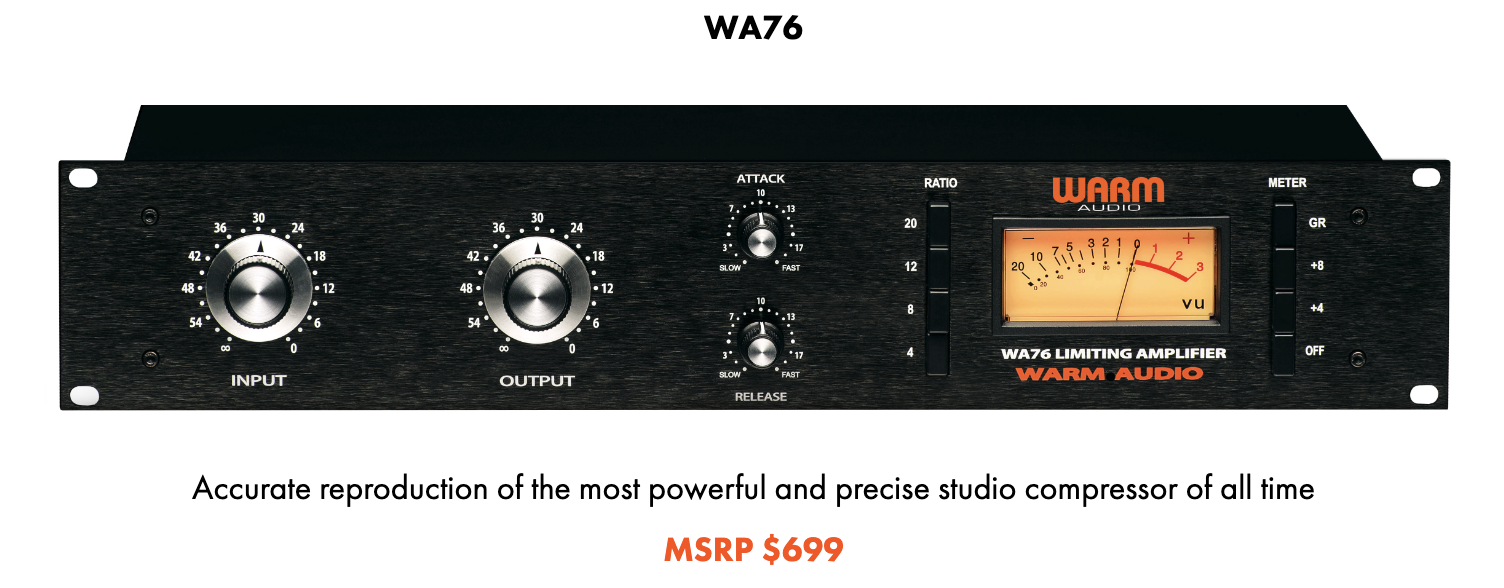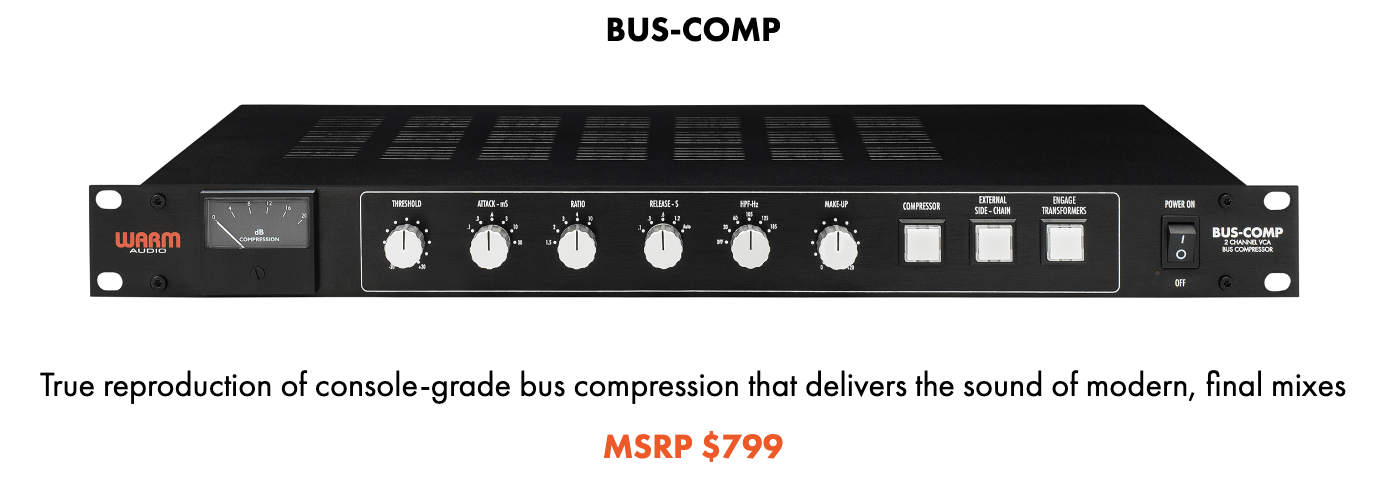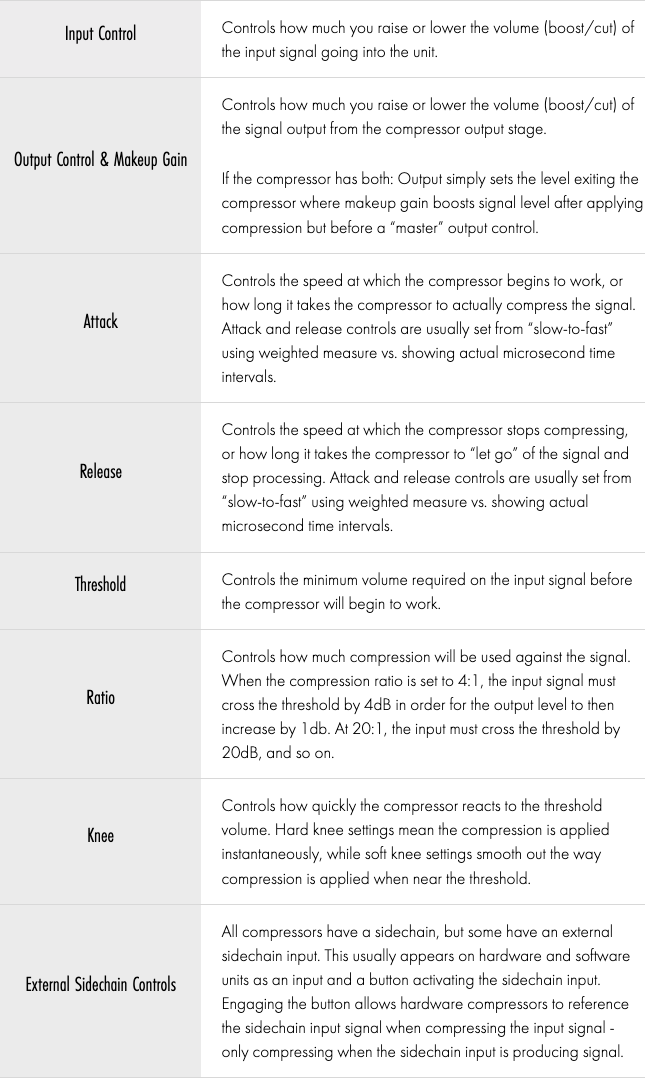What You Need to Know To Capture Your Best Sound
Compression is a critical component of all professional audio signal chains. Provided you have a quality microphone preamp to get the most out of your microphones and audio sources, adding a discrete analog compressor to your chain is the next step towards achieving professional sound quality in your recordings.
In this guide, we will be covering what compression actually does to audio signals, a brief history of analog compression, what types of compressors exist, and what sonic differences exist between each.
As for how compression can be used, we will mostly be talking about tracking with compression “on the way in”, or “in line” with a mic preamp while initially recording your sound sources. Example instruments and recommendations below include pop vocals and fingerstyle acoustic guitar. We will also quickly discuss using compression “in post” on a mix bus.
Compressor History, Types, & Sound Profiles
Hardware compression for audio signals was created in the 30’s and made commercially available in the late 30’s - 40’s for its main use: Radio broadcast. In simplest terms, compression controls the change in volume in an audio signal. Raising the volume on the softest sounds, and lowering the peak volume on the loudest sounds - making a more consistent signal. This variance in volume is called dynamic range. For this reason, the audio hardware tools in this category, compression and limiting amps, are referred to as dynamics processors. Because varying radio personalities and different shows, music, and effects had a great degree of dynamic range, the broadcast companies needed a way to control this issue and reduce overmodulation. During overmodulation, parts of the signal would “clip” or distort, and that caused not only the signal, but entire broadcasts to fail.
Like their broadcast counterparts, professional recording engineers quickly adopted the technology, saving themselves tedious hours riding the faders, or controlling the gain while tracking a performance. This is extremely helpful because it allowed the engineers to prevent distortion which could cause unusable takes being recorded to tape (very expensive). Even in a “post-tape” world where so many of us are recording straight into a DAW, controlling dynamics on the way in allows audio engineers to listen more during the tracking process and makes it much easier for producers/engineers to focus on the music.
Types Of Compressors
Optical
As the name implies, optical compressors use a light-based electrical component called an opto-cell that uses light to transfer electrical signals from origin to destination.The actual light source inside the unit will glow anywhere from dim to bright depending on the strength of the input signal. As gain reduction (compression) is applied in response to brighter light, the higher volume (peaks) are reduced. Once the light dims beyond the desired brightness, the gain reduction stops. Words often used to describe optical compressors include smooth, light, and forgiving. They are not quite as “fast” as FET compressors, and can not get as punchy or authoritative as VCAs. Because of this, one might reach for an opto compressor on sources where they want more natural dynamics of the performance to be preserved. When outboard gear imparts harmonic distortion, imperfections to the signal are introduced and we often prefer how that sounds compared to “clean” dynamics processing.
There are a few very famous optical compressors. The Tube Tech CL1B is a modern classic. And of course, possibly the most iconic studio compressor of all time is the “2A-Style” compressor - originally released by Teletronix in the mid-sixties. The Warm Audio WA-2A is an authentic reproduction of this most coveted compressor and leveling amplifier.

Tube / Vari-Mu Compression
Tube compressors use tubes to reduce gain in audio signals. (We need to recognize that well-known Optical compressors, like the LA-2A and CL1B, have tubes as part of the circuit, but the compression is not controlled by the tubes in those.) This type of compressor mostly operates as a push-pull amplifier with matched tube compression circuits with opposite polarity. Put simply, as the input audio signal volume increases, the amount of current sent to the tubes decreases. The most famous examples of tube compressors are the Fairchild 670, and the ultra-unattainable RS124 tube compressors at Abbey Road studios.As for sound, tube compressors have even slower attack time than optical units. Because of this, not all transients are squashed. This sound profile lends itself to both individual tracks with a desire for more dynamic preservation as well as instrument groups and the mix bus. Best used in any scenario where you don’t want to squash the sound as much as you want to add a little control to varying dynamics in groups of instruments.
FET (Field-Effect Transistor)
Moving on a bit in history, the creation of the FET compressor gave engineers an entirely new class of technology in terms of attack time. With the ability to set rapid attack and release times, FET compressors excel on individual instruments where adding a little saturation and harmonic distortion is welcomed. This is what folks mean when they use phrases like “color”, “analog tone”, and “punchy.” When outboard gear imparts harmonic distortion, imperfections to the signal are introduced and we often prefer how that sounds compared to “clean” dynamics processing. Compared to the 2A style of compression that imparts rich harmonic distortion with its slower attack, the faster attack of the FET has a recognizable saturation when the unit is pushed.The most famous FET compressor of all time is the 1176 Peak Limiter created by UREI in 1967. Known for its incredible versatility and pleasing saturation, 76-style compression is the go-to when dynamics need to be more controlled, with a larger reduction in dynamic range than an optical compressor might be able to provide. A nice byproduct of the design is the signal saturation that can be present on the 76. Especially in the “all buttons in” mode, where selecting all 4 ratios at the same time will deliver subtle overdriven compression, specifically on the lower frequencies. This makes the 76-style unit a very popular compressor for drum room mics while tracking. The Warm Audio WA76 is an accurate reproduction of this most powerful and precise studio compressor.

VCA (Voltage Controlled Amplifier)
The first VCA compressors began to show up around studios in the early 1970’s. Unlike optical, tube, and FET compressors, VCA compressors actually use ICs (integrated circuits - Op-Amps) to diagnose the input voltage. The control signal is applied against the variable signal to decide whether to apply gain or not. The design and required components of VCA compressors allow them to be extremely versatile, transparent, precise, and physically smaller than older designs. While it’s easy to find examples of VCA compression on individual instruments, the most celebrated use for VCA compression is on mix buses and purposefully grouped tracks. One of the most popular VCA console-style bus compressors also has an external sidechain input, unlocking mixing and sound design options for multiple sources. Simply put: external sidechain compression uses a track from one instrument as a reference point to create complementary compression on another source. Sending a signal, say, a kick drum to the external sidechain input allows you to tell the compressor when to compress another track, say a bass guitar, and when to bypass. When the kick hits - compression. Two bars of dead air - no compression. See examples below for how to use external sidechain compression!
The most popular VCA compressors are the dbx 160 and the beloved bus compressors on SSL G-Series consoles. For budget-friendly, world-class compression, check out our BUS-COMP - A True reproduction of the world-class SSL G-Series bus compressor delivering the signature sound of final mixes for 20 years.

PWM (Pulse Width Modulation)
A lesser-known type of compression, PWM or pulse wave modulation compression, operates by using ultra-high-frequency signals to control the volume of a signal over a given period of time. The volume controlled is the average, not just the highest of highs, known as “peaks”. This method manipulates the signal into several parts and then reduces the volume at certain points - thus controlling the variable dynamics of the original audio signal. Because the signal is displaced into multiple parts and the average volume is well controlled, less harmonic distortion is introduced. Because of these reduced imperfections, PWM compression is often considered transparent and has incredibly fast attack and release times.The most historically significant PWM compressor is the Pye 4060 released in the sixties. The Great River PWM-501 is considered a modern classic by 500-series enthusiasts.
Examples & Recommendations
Example Setup: Pop Vocals
Sources: Lead vocals for pop music
Desired sound profile/result: Present, crisp, clear vocals. Out in front of the mix and consistent
Associated gear: computer & DAW, audio interface, preamp, condenser mic, XRL & balanced cables
Compressor recommendation: WA-76 Discrete FET Compressor ($699)
Why this recommendation?
When we hear pop vocals on our streaming device or the radio, the vocals don’t just cut out and randomly increase in volume. However, when we listen to a vocal performance in person, the human voice is dynamic, making it impossible to hit varying notes across frequencies without changes in volume. This dichotomy of how things are and how they need to be perfectly make the case for a powerful and versatile compressor.The WA-76 compressor has a large amount of “control” in the circuit and handles a variety of sources and dynamics processing issues very well. This is because the “newer” FET technology (newer relative to optical and tube) is able to attack and release much quicker than some of the older technology. Unlike tubes, the color and saturation of FETs “kicks in” at louder input volume, giving these compressors more clean headroom as a part of the signal chain. Compared to operatic vocals for instance, pop vocals need heavier dynamics processing, ensuring consistent volume throughout the lead vocal performance. Because of this need for maximum clarity and accessibility, the WA-76 can help produce clear, consistent vocals so that audiences can connect with the lyrics. While that clean headroom is an important part of the utility of the WA-76 in the studio, the circuit still allows for smooth FET saturation when needed - especially on drums and room mics!
BONUS: A fun technique for great pop vocals: run the vocals into a WA-76 and then send that signal to a WA-2A. Most of our compression is coming from the WA-76, about 5-7dB of gain reduction. The WA-2A then acts as a traditional limiter, reducing 1-2dB of gain. The addition of the WA-2A rounds out the vocal track and helps the track sit better in the mix.
Example Setup: Fingerstyle Acoustic Guitar
Sources: Solo acoustic guitar - one or two mics, no accompaniment
Desired sound profile / result: Clear, polyphonic, balanced, significant dynamic preservation
Associated gear: computer & DAW, audio interface, preamp, condenser mic, XRL & balanced cables
Compressor recommendation: WA-2A Tube Optical Compressor ($949)
Why this recommendation?
When recording a fingerstyle acoustic guitar performance, the guitar needs to stand out since it’s a solo instrument. Compare this to recording a basic acoustic guitar rhythm for a large, multitrack mix. The role of the acoustic guitar in that large mix is very different because the guitar needs to compliment the other tracks to sit properly in the mix. This is why “tracking acoustic guitar” is not always treated the same way.With acoustic fingerstyle guitar, the instrument is recorded in mono or stereo and lacks accompaniment. Because this is a solo instrument, a certain amount of dynamics preservation is required to maintain some level of natural intimacy in the performance. Knowing this, it’s best to reach for a more forgiving, smooth and “slow” compressor that might impart a little extra desirable saturation. The WA-2A is the ideal compressor for applications like this, where it’s desirable for there to be subtle changes in volume based on the way a musician is performing. While the WA-2A will control dynamics, making the signal more clear, it won’t quite restrict the natural dynamics of the performance in the same way a FET compressor would. The 2A-style compression at its best almost sounds like you’re in the room for the best live version of a song that you’ve ever heard in the perfect acoustic environment.
BONUS: On the WA-2A, the pre-emphasis is essentially a hi-pass filter. If you set the pre-emphasis to 12 o’clock, you will let more rich low end come through while compressing more midrange and high end. For acoustic guitar, this really gives that “in the room” rounded out sound.
Example Setup: Mix Bus & Track Groups
Sources: Stereo compression on final mixes, track groups
Desired sound profile / result: Create consistency in a mix, transparent, punchy, clean, balanced tone
Associated gear: computer & DAW, 2x4 (minimum) audio interface & balanced cables
Compressor recommendation: BUS-COMP VCA Console-Style Bus Compressor ($799)
Why this recommendation?
The Warm Audio BUS-COMP is a fantastic compressor for tracking instruments in its own right, but for this example we’re going to focus on using the unit on sources that have already been tracked. When we talk about using a compressor on the mix bus, or track group, what we mean is that we are applying an effect across an entire collection of tracks, combined as one stereo signal. When we talk about using a compressor on the mix bus, or track group, what we mean is that we are applying an effect across an entire collection of tracks, combined as one stereo signal otherwise known as a stereo bus. So say you have a 10 track mix on a master bus, the BUS-COMP would apply the compression/effect to all channels fed into the stereo left and right channels of the master bus. Because the BUS-COMP has all of the punchy and clear tones of the original vintage console VCA compressors, with premium CineMag transformers in the signal path, it’s the ideal compressor to send your track groups and mixes through. Whether you need subtle dynamic control across an entire mix for radio-ready tracks, or you really want to create a “pumping” sensation for clubs and stereo systems by using the BUS-COMP’s external side chain, this VCA compressor is the ideal choice for final mix and grouped-track compression.
BONUS: External Sidechain Quick Setup Guide
Sources: Bass Guitar (processed instrument) and Kick Drum (external sidechain input)
Desired sound profile / result: “Glue” the bass track and kick drum together in the mix
Associated gear: computer & DAW, 2x4 (minimum) audio interface & balanced cables
Compressor recommendation: (2X) BUS-COMP VCA Console-Style Bus Compressor ($799)
Where Should I Start?
To best trial using the sidechain input, you should first compress your source, say bass guitar, to your liking. A/B the compressed signal vs. uncompressed signal both solo’d and in the mix to make sure you're happy with how compression is being applied to the bass guitar. You can then run an output of the kick drum into the external sidechain input of the compressor. The compressor will use the kick drum input signal as the reference point to decide when to compress the bass signal. If the bass is only compressing when the kick drum is engaged, this can create a tighter sound in the rhythm section. This technique is very popular in dance, electronic and pop music for the heartbeat or pumping feel it can bring to the groove of the track.
BONUS: Common Compression Controls & Basic Compression Comparison Charts
Common Compression Controls

Basic Compressor Comparison Chart

